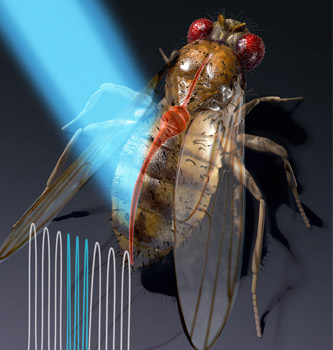Moving Youth Toward Success

Lee Kern believes that all high-schoolers should be screened for social, emotional and behavioral problems. Doing so could help head off larger problems down the road, she says.
High-school students experiencing severe mental health and behavioral disorders often drop out of school, have trouble getting jobs or wind up in jail, says Lee Kern, professor of special education. How best to intervene so that students' problems can be minimized?
That question was central to a large, five-year study led by Kern and conducted by researchers at Lehigh and six other institutions—Ohio University, the University of Missouri, the University of South Carolina, the University of Kansas, the University of Houston (TIMES) and Miami University of Ohio. With more than $10 million in funding from the U.S. Department of Education, they established the Center for Adolescent Research in Schools (CARS), working with more than 600 students at 54 high schools. Twelve of the schools were in Pennsylvania's Lehigh Valley and the surrounding region.

"Older students with emotional and behavioral problems have long been neglected," Kern says. "Very little research is conducted with this age group, so we lack information about effective interventions. Teachers are reluctant to provide supports because they expect adolescents to be independent. And the nature of most high schools—in which students have multiple teachers, none of whom usually gets to know them well—makes identification and service delivery difficult."
The CARS team developed and evaluated a range of interventions, including mentoring, to help reduce the difficulties that students with severe mental health and behavior disorders experience. They also developed a model for delivering services.
The study provided a rich data pool, allowing researchers to not only assess the effectiveness of various interventions but also the kinds of mental health services that students received, where and at what age they received them, and the link between the severity of their problems and the types of services provided. They're looking at whether interventions failed because they weren't implemented as designed and whether students' ethnicities, family incomes and school locations figure into who gets services.
"We're looking at the outcomes different ways," Kern says. Of great concern to the researchers, based on the findings, was that students with severe mental health and behavioral disorders weren't always getting the services they needed, such as interventions and classroom supports.
In launching the project, researchers asked school officials to refer students with the most intensive social, emotional and behavioral problems; they did not specify whether the students should be diagnosed as in need of special education. As a result, Kern says, about half of the students in the study had a special education diagnosis and half did not.
Except for lower academic performances among students with learning disabilities, researchers found that on every standardized measure there were no differences between those who had received special education diagnoses and those who had not.
"So if we're talking about depression, we have kids who are significantly depressed who are identified as having emotional and behavioral disorders, and they're guaranteed services by the school," she says. "We have another group of students, which is probably just as many, who are depressed but not guaranteed any kinds of services because they are not identified as having behavioral disorders."
Kern says the researchers see a need to screen all high-schoolers for social, emotional and behavioral problems because schools, through their special education identification systems, are just not picking up all the adolescents with significant needs.
If schools don't provide interventions, she says, "it's unlikely kids will get any kind of services for their mental health needs. Very few kids get community services. And when they do, they usually go once or twice, so they're not getting a sufficient dosage to really make a difference."
Such services need not be expensive to administer, especially when looking at cost-benefit ratio, she says. Most interventions can be group-delivered, providing effective ways to reduce students' anxiety and depression. "It's just that schools don't think they're responsible for providing them," Kern says. "Whether that's right or not, we know that if they don't provide them, students are not going to get them."
Schools also can reduce the stigma associated with mental health services by making programs available schoolwide, she says.
Using a mapping process, the researchers also found that school resources were not being used effectively. "For example, school staff spent a lot of time responding to crises, rather than putting preventative interventions in place," she says. "Also, trained school staff, including counselors, spent a lot of time on tasks such as scheduling that do not capitalize on their skills." Among interventions, a Check & Connect mentoring program proved valuable, regardless if students were paired with someone of the same gender and ethnicity. "That's a positive finding, that it doesn't matter who your mentor is," Kern says. "Just the mentoring process itself is really helpful to these students."
It's important for practical reasons too, since it's sometimes difficult to find mentors in the schools who match students in race and gender. In the project, mentors were mostly teachers, but also coaches and administrators who met with the students once a week and talked about schools and future plans, and sometimes, family and friendships. Mentors also reviewed dropout indicators such as grades, absences and tardiness. Both the students and mentors rated the relationships very highly.
The CARS team also found that students with severe emotional and behavioral problems reported a lower quality of life than other adolescents, a finding consistent with other research. While those who work with the troubled students tend to focus on reducing problem behaviors, the team is assessing whether there needs to be more focus on other indicators of quality of life. Do students feel safe at home? Do they feel they have friends? Do they participate in activities they find enjoyable?

Given the students' high dropout rates and poor school outcomes, researchers were not surprised to find that students with severe emotional and behavioral problems were unhappy at school. However, interventions that can increase students' satisfaction with school are important, the data suggests. It's likely, researchers said, that students who feel better about school will do better academically and stay enrolled. The CARS team also found that high school girls with severe emotional and behavioral problems reported being less satisfied than high school boys with their families, themselves and life in general. Whether that's due to differences in development, gender expectations or the availability of interventions, the researchers see a need to carefully examine the appropriateness and effectiveness of interventions for adolescent girls.
Latino students also were found to be significantly less satisfied than black students with their lives, but further study is needed.
Findings have so far been published in the Journal of Emotional and Behavioral Disorders, School Psychology Review, Journal of Clinical Child and Adolescent Psychology, Journal of Behavioral Education and Review of Educational Research. More papers are pending.
The researchers have made recommendations to the U.S. Department of Education, including the possibility of funding schools that can be models for educators.
"Once we find schools that are doing good things, [we should] support them in doing those things, collect the data that they aren't able to collect, show that they have good outcomes and then these schools are much more visible," Kern says. "People can see, this is how you do it, this is the structure, this is how you allocate resources."
Lee Kern’s research interests include emotional and behavioral disorders, positive behavior support, school-based interventions and attention-deficit/hyperactivity disorder (ADHD). She received her Ph.D. from the University of South Florida.
Story by Mary Ellen Alu
Illustration by Michelle Thompson
Posted on:






